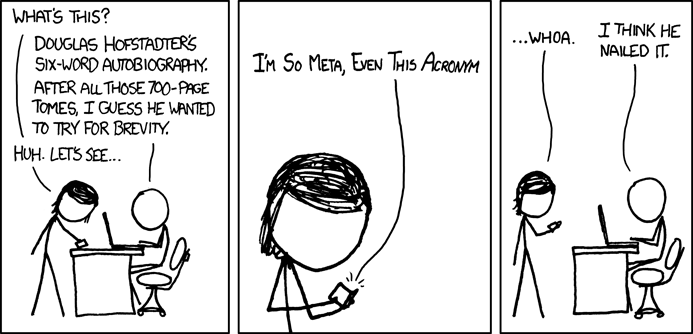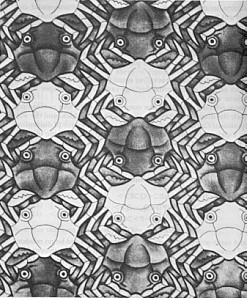 I don't quite know how I decided that the best way to follow up Steven Pinker's epic history of violence was by picking up another 700 page mammoth, but apparently this did happen, which is why I spent the Christmas holidays trekking through Douglas Hofstadter's most famous work, Gödel, Escher, Bach: an Eternal Golden Braid. For a certain type of geek, this is as close as you can come to a sacred book, with Hofstadter as some kind of god, or at least a prophet. When mentioned online, it is referred to with reverence, as its devoted followers drown out the odd detractor, with their unrestrained praise.
I don't quite know how I decided that the best way to follow up Steven Pinker's epic history of violence was by picking up another 700 page mammoth, but apparently this did happen, which is why I spent the Christmas holidays trekking through Douglas Hofstadter's most famous work, Gödel, Escher, Bach: an Eternal Golden Braid. For a certain type of geek, this is as close as you can come to a sacred book, with Hofstadter as some kind of god, or at least a prophet. When mentioned online, it is referred to with reverence, as its devoted followers drown out the odd detractor, with their unrestrained praise.That may be overdoing it a little (or a lot), but the point still stands that a fair number of people consider this book to have played a major part in their lives. Entire university courses can be based around it.
At this point, I should probably try to summarise what the book is actually about, although I confess to being slightly nervous about doing so. Whilst fairly confident that I understand its central messages, I wouldn't say that I'm certain, and it wouldn't surprise me if some subtle point has passed me by.
It is not about Kurt Gödel, M.C. Escher, and J.S. Bach, at least not centrally. Instead, the main thesis of the book concerns how meaning can arise from meaningless symbols, by using formal systems which contain tricks such as self-reference, self-replication, recursion and strange loops, and by using tools such as paradox, infinity, and isomorphism, and particularly examining how this relates to the emergence of intelligence from unintelligent neurons. Throughout the book, the works of the three geniuses in the title are used as a touchstone to which all these concepts can be linked to, showing how the same ideas are mirrored in their work, and in real life.
So how is it that a book essentially about artificial intelligence, yet first published in 1979 at a time when humans still dominated computers in chess, has managed to stay relevant, and kept people reading and waxing lyrical about it? Indeed, the author even makes the unfortunate prediction that computers won't be able to beat all humans at chess until they have attained a similar level of general intelligence.
The book is curiously structured. Alternating with the actual chapters are fictitious dialogues he has created between Achilles and the Tortoise (borrowing an idea from Lewis Carrol), along with assorted others, which introduce key concepts that are about to be discussed. All these dialogues are based on pieces by Bach, so often follow the form of a fugue or a canon.
The first half of the book is spent examining formal systems, where certain rules of inference and a set of axioms are given, and theorems can be derived by strict application of the rules to the axioms or theorems. Rules of inference are simply typographical, that is to say that there may not be any meaning to them, they just describe in what ways you are allowed to move symbols around. Simple systems are presented first, building in complexity until Typographical Number Theory is reached, a system completely isomorphic to that of the concepts used in actual number theory, that is to say that for every component that serves a particular function in TNT, there is an equivalent component in number theory.
 Part one closes with perhaps my favourite chapter in the book. It starts in a round about way by taking a look at Zen Buddhism (which isn’t endorsed), but quickly continues into the world of Gödel numbering, and a proof of Gödel's famous incompleteness theorem. I can no longer remember where I first heard about this theorem, but I do recall being amazed by it at the time. What Gödel demonstrated is that all statements of number theory can be given a special number, and that all rules of inference can be mapped onto arithmetical operations onto those numbers. A number can then be created which when deciphered says, ‘I am not a theorem of Typographical Number Theory.’ If this is true, then there exists a true statement which cannot be proven in TNT, demonstrating its incompleteness. If it is false, then there are theorems in TNT which are untrue, meaning it is inconsistent.
Part one closes with perhaps my favourite chapter in the book. It starts in a round about way by taking a look at Zen Buddhism (which isn’t endorsed), but quickly continues into the world of Gödel numbering, and a proof of Gödel's famous incompleteness theorem. I can no longer remember where I first heard about this theorem, but I do recall being amazed by it at the time. What Gödel demonstrated is that all statements of number theory can be given a special number, and that all rules of inference can be mapped onto arithmetical operations onto those numbers. A number can then be created which when deciphered says, ‘I am not a theorem of Typographical Number Theory.’ If this is true, then there exists a true statement which cannot be proven in TNT, demonstrating its incompleteness. If it is false, then there are theorems in TNT which are untrue, meaning it is inconsistent.The result can then be shown to be applied more generally: Any formal system powerful enough to express basic arithmetic can not be both complete and consistent at the same time. When first proven in 1931, this result flew against the conventional view that mathematical was be capable of expressing and proving all numerical truths, as championed by Bertand Russell and Alfred North Whitehead in their multi-volume work, Principia Mathematica.
The experience of having sudden revelations when working on maths problems is not uncommon, and as I read this chapter, and the argument was slowly built up, it felt like I was being hit by many of these epiphanies and moments of sudden clarity in quick succession. Mathematical logic is likely a new world to most people, and therefore provides fertile ground for novel, revelatory insights
Part two has greater focus on how what has been discussed before can be mapped onto human experience, and the possibility of artificial intelligence. Although certainly still interesting, these sections felt much less exciting than the more abstract conversations, which feel a lot more like they make up the heart of the book. There are fewer works by Escher to look at, fewer references back to Bach, and a lot more speculation.
 |
| Reptiles by Escher, showing how things move between levels |
The problem is more that compared to the earlier, more exotic and unusual material of the earlier sections, these parts feel just a bit too normal.
However, I am certainly selling Hofstadter short here. Artificial intelligence has made its way into the mainstream consciousness, so seems more familiar, but even from a perspective thirty years behind, he offers compelling ways to think of how the brain might be organised, and how to think about concepts such as free will. In particular, the ‘Ant Fugue,’ is one of the best examples of how a dialogue can be used to provide instant intuition about difficult ideas.
The book can be a difficult read, even if you ignore its length. Some sections need to be reread several times through before you can follow along with the reasoning, especially in those sections where lots of new notation and symbols are used. I had the experience in several places of feeling that I understood the topic, before looking back later and realising that I would be hard-pressed to offer an explanation of what had been going on. Hopefully enough of the ideas will have stuck with me, even if the proofs fade from memory. It is definitely a book that would reward a complete reread at some point in the future, though preferably not for a while...
The flip-side of this is that Hofstadter tries to examine ideas from as many different angles as possible (in musical terms, through augmentation, inversion, and other variations of the main theme), which can occasionally result in sections feeling repetitive or even redundant.

There are times when you feel that Hofstadter is slightly too aware of his own cleverness. During chapters, he will often point how a concept he has just been discussing was incorporated into a previous dialogue, revealing yet another meaning that the reader has likely missed the first time round. At various points, he leaves exercises or problems for the reader to do to test their understanding, which results in him sounding a bit too much like a teacher, with the book as just a textbook.
A particularly irritating manifestation of this quirk comes in a dialogue more than 300 pages from then end, where he seems to suggest that he may have attached extra padding material onto the end of the book, in such a way that an intelligent reader would be able to distinguish where the real book finishes if he were to look carefully enough. When trying to work through such a massive thesis, this is not the sentiment you want to come across. I found myself thinking, 'I'm taking the time to try and read and understand your book, Hofstadter. Why would you do this?'
 |
| Crab Canon by Escher, there is also a dialogue in the form of a crab canon |
When yet another formal system is introduced, it can initially seem pointless, but always ends up with valuable insights and the discovery of yet more isomorphisms.
If Hofstadter has the impression that he is quite intelligent, then his impression is totally accurate. The dialogues really are exceptionally clever, and all of them contain multiple levels of meaning and wordplay. They are intricate, playful, subtle, informative, and definitely the parts of the book I looked forward to most.
As for his comment about secretly finishing the book early, I suppose this is funny, as long as he didn’t actually carry out this threat.
Gödel, Escher, Bach then, is a long, meandering odyssey through a swarm of concepts that you won’t find anywhere else, with original combinations and connections explored in a way that is unique. If you start the journey with a cynical frame of mind, you will probably be able to find enough places where you can confirm your doubts, but if you start with a little trust in Hofstadter’s genius, then you can push through, and enjoy the sensation of being able to appreciate Bach even more deeply, of understanding what it is exactly that is under examination in Escher’s work, and of knowing how Gödel's incompleteness theorem reveals something about the way our minds work.
why would you do this?
ReplyDelete